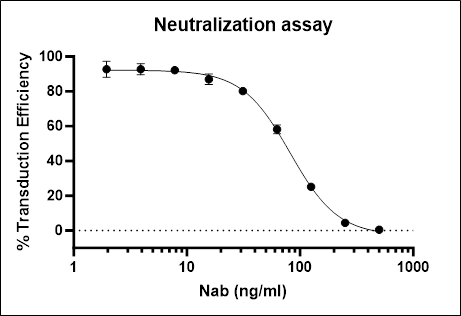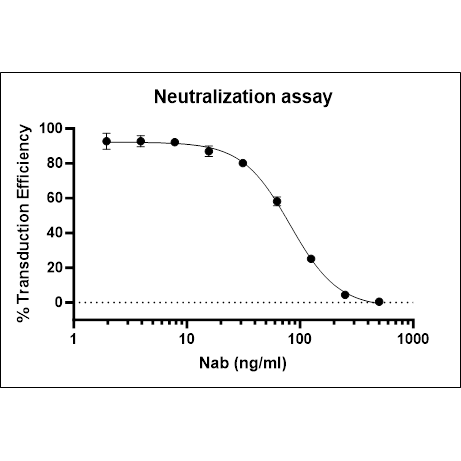AAV2 (intact particle) Recombinant Mouse mAb (S-R435) to be tested were diluted a series of gradients (from 500ng/ml, 2 fold, 9 points) ,and each gradient was co-incubated with AAV2 virus, the mixture was infected with 293T cells after incubation, and RLU luminescence value was detected.
Product Details
Product Details
Product Specification
| Host | Mouse |
| Antigen | AAV2 (intact particle) |
| Clone Number | S-R435 |
| Antibody Type | Mouse mAb |
| Isotype | IgG3,k |
| Application | ELISA, Neutralization |
| Reactivity | Adeno-associated virus 2 |
| Purification | Protein A |
| Concentration | 1 mg/ml |
| Conjugation | Unconjugated |
| Physical Appearance | Liquid |
| Storage Buffer | PBS, 40% Glycerol, 0.05% BSA, 0.03% Proclin 300 |
| Stability & Storage | 12 months from date of receipt / reconstitution, -20 °C as supplied |
Background
Adeno-associated Virus 2 (AAV2) is a non-pathogenic parvovirus belonging to the adeno-associated virus family. AAV2 virus particles measure approximately 22 to 25 nanometers in diameter. Its capsid consists of 60 identical protein subunits, primarily composed of VP1, VP2, and VP3 proteins, with VP3 being the most abundant, accounting for about 80% of the total subunits. Inside the AAV2 particle lies a single-stranded DNA molecule of approximately 4.7 kilobase pairs, encoding two main genes: rep and cap. These genes encode proteins involved in viral replication and capsid assembly, as well as proteins that constitute the viral capsid. The DNA molecule is flanked by inverted terminal repeats (ITRs), which play a crucial role in viral DNA replication and integration into the host genome. AAV2 binds to host cell surface attachment factors and nuclear receptors, primarily heparin sulfate proteoglycan (HSPG), with fibronectin and its associated integrins serving as cofactors. This binding mediates the endocytosis of AAV2, which then matures through the endoplasmic reticulum and Golgi apparatus before reaching the nucleus. Inside the nucleus, the single-stranded DNA is converted to double-stranded DNA, triggering downstream gene expression. AAV2 is widely used in gene therapy due to its ability to transduce both dividing and non-dividing cells, low immunogenicity, high transduction efficiency, and broad tissue tropism. It has been employed in treating various genetic diseases, such as lipoprotein lipase deficiency and retinitis pigmentosa.
Picture
Picture
Validation Data



